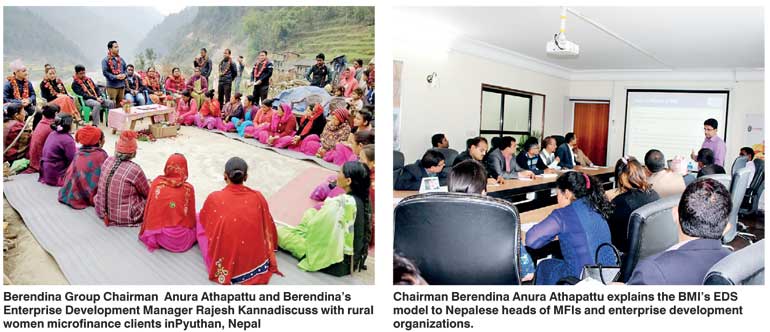Wednesday Mar 12, 2025
Wednesday Mar 12, 2025
Friday, 31 March 2017 04:11 - - {{hitsCtrl.values.hits}}
The Sakchyam Access to Finance for the Poor Program (Sakchyam) in Nepal recently invited a Sri Lankan team from Berendina Microfinance Institute (Gte) Ltd (BMI) to conduct a feasibility study to replicate or adopt the Enterprise Development Services (EDS)model being implemented by the Berendina Group in Sri Lanka.
Berendina Group Chairman Anura Athapattu and Berendina’s Enterprise Development Manager Rajesh Kanna were involved in the feasibility study conducted in Chitalang, Gulariya and Pyuthan of Rural Nepal from 20th to 24th of March 2017.
“At the workshop held with Microfinance Institutions (MFIs) and enterprise development practitioners, it was observed that they were keen to replicate the model while Sakchyam offered all their partner MFIs a grant funding to cover replication of the BMI – EDS model,” Berendina Chairman Athapattu said on conclusion of the tour.

The BMI operation has supported thousands of families in Sri Lanka enhance income levels by implementing a unique “credit plus approach”. This is where credit is provided to individuals in the poorest strata of the society along with several other tied-up training services in a financially sustainable manner. As result of this, BMI was called upon to interact with Microfinance Institutions (MFIs) in Nepal to explore the feasibility of emulating the model to develop and support micro and small level enterprises in that country.
BMI, a non-governmental-organization is one of Sri Lanka’s top microfinance service providers and has a client base of over 100,000 persons spread in the remotest of regions in Sri Lanka.
Sakchyam is an initiative funded by UKaid as part of an agreement between the Governments of Nepal and the UK. It is implemented by Louis Berger for the Department for International Development (DFID Nepal) in partnership with local and international institutions.
The 5-year program, valued at US$25.77 million, is working with the public and private sectors to leverage access and facilitate financial sector development in Nepal for small and medium enterprises (SMEs) and for poor people with a focus on the Mid- and Far-Western Regions (MWDR and FWDR), and beyond.
Discover Kapruka, the leading online shopping platform in Sri Lanka, where you can conveniently send Gifts and Flowers to your loved ones for any event including Valentine ’s Day. Explore a wide range of popular Shopping Categories on Kapruka, including Toys, Groceries, Electronics, Birthday Cakes, Fruits, Chocolates, Flower Bouquets, Clothing, Watches, Lingerie, Gift Sets and Jewellery. Also if you’re interested in selling with Kapruka, Partner Central by Kapruka is the best solution to start with. Moreover, through Kapruka Global Shop, you can also enjoy the convenience of purchasing products from renowned platforms like Amazon and eBay and have them delivered to Sri Lanka.
Discover Kapruka, the leading online shopping platform in Sri Lanka, where you can conveniently send Gifts and Flowers to your loved ones for any event including Valentine ’s Day. Explore a wide range of popular Shopping Categories on Kapruka, including Toys, Groceries, Electronics, Birthday Cakes, Fruits, Chocolates, Flower Bouquets, Clothing, Watches, Lingerie, Gift Sets and Jewellery. Also if you’re interested in selling with Kapruka, Partner Central by Kapruka is the best solution to start with. Moreover, through Kapruka Global Shop, you can also enjoy the convenience of purchasing products from renowned platforms like Amazon and eBay and have them delivered to Sri Lanka.